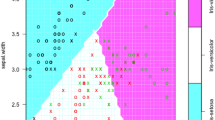Abstract
Heart rate variability (HRV) is often used to assess the risk of cardiovascular disease, and data on this can be obtained via electrocardiography (ECG). However, collecting heart rate data via photoplethysmography (PPG) is now a lot easier. We investigate the feasibility of using the PPG-based heart rate to estimate HRV and predict diseases. We obtain three months of PPG-based heart rate data from subjects with and without hypertension, and calculate the HRV based on various forms of time and frequency domain analysis. We then apply a data mining technique to this estimated HRV data, to see if it is possible to correctly identify patients with hypertension. We use six HRV parameters to predict hypertension, and find SDNN has the best predictive power. We show that early disease prediction is possible through collecting one’s PPG-based heart rate information.





Similar content being viewed by others
References
Jeyhani, Vala, et al. "Comparison of HRV parameters derived from photoplethysmography and electrocardiography signals." 2015 37th Annual International Conference of the IEEE Engineering in Medicine and Biology Society (EMBC). IEEE, 2015.
Allen, J., Photoplethysmography and its application in clinical physiological measurement. Physiological measurement 28.3:R1–R39, 2007.
Melillo, P. et al., Automatic prediction of cardiovascular and cerebrovascular events using heart rate variability analysis. PloS one 10.3:e0118504, 2015.
Zhang, Z., Photoplethysmography-based heart rate monitoring in physical activities via joint sparse spectrum reconstruction. IEEE Transactions on Biomedical Engineering 62.8:1902–1910, 2015.
Adidas. Adidas miCoach, "real time voice coaching and zone based cardio training". Available from: http://micoach.adidas.com/.
Mio. "Continuous heart rate monitoring technology without a chest strap". Available from: http://www.mioglobal.com/mio-continuous-heart-rate-technology.htm.
Nellcor. "Nellcor N-65 Pluse Oximetry Monitor". Available from: http://www.covidien.com/rms/products/pulse-oximetry/nellcor-n65-pulse-oximetry-monitor#features.
Gacek, Adam, and Witold Pedrycz, eds. ECG signal processing, classification and interpretation: A comprehensive framework of computational intelligence. Springer Science & Business Media, 2011.
Peel III, Harry H. "System and method for accurately monitoring the cardiovascular state of a living subject." U.S. Patent No. 5,931,790. 3 Aug. 1999.
Bruser, C. et al., Adaptive beat-to-beat heart rate estimation in ballistocardiograms. IEEE Transactions on Information Technology in Biomedicine 15.5:778–786, 2011.
Selvaraj, N. et al., Assessment of heart rate variability derived from finger-tip photoplethysmography as compared to electrocardiography. Journal of medical engineering & technology 32(6):479–484, 2008.
Arumugam, J. M. R., and Mary, A., Heart rate variability a cardiac indicator in diabetic autonomic neuropathy: A systematic review. International Journal of Medical Research 1.2:13–16, 2013.
Patrick, T. H. H. et al., Cardiovascular diagnostics mining on Borneo island: From labour-intensive to prototype. Informatics for Health and Social Care 34.1(1):–9, 2009.
Mussalo, H. et al., Heart rate variability and its determinants in patients with severe or mild essential hypertension. Clinical Physiology 21.5:594–604, 2001.
Raghunath, M. T., and Narayanaswami, C., User interfaces for applications on a wrist watch. Personal and Ubiquitous Computing 6.1:17–30, 2002.
Pandian, P. S. et al., Smart Vest: Wearable multi-parameter remote physiological monitoring system. Medical engineering & physics 30.4:466–477, 2008.
Gertsch, Jeffrey H., et al. "Electronic helmet." U.S. Patent No. 8,001,623. 23 Aug. 2011.
Google. "Google Glasses Development Kit." Available from: https://developers.google.com/glass/.
Poh, M.-Z. et al., Cardiovascular monitoring using earphones and a mobile device. IEEE Pervasive Computing (4.11):18–26, 2012.
Rhee, S., Yang, B.-H., and Asada, H. H., Artifact-resistant power-efficient design of finger-ring plethysmographic sensors. IEEE Transactions on Biomedical Engineering 48(7):795–805, 2001.
Warren, K. M. et al., Improving pulse rate measurements during random motion using a wearable multichannel reflectance Photoplethysmograph. Sensors 16.3:342, 2016.
Merilahti, J. et al., Compliance and technical feasibility of long-term health monitoring with wearable and ambient technologies. Journal of telemedicine and telecare 15.6:302–309, 2009.
Mazzù, M. et al., Wireless-accessible sensor populations for monitoring biological variables. Journal of telemedicine and telecare 14.3:135–137, 2008.
Chen, W. et al., Design of an integrated sensor platform for vital sign monitoring of newborn infants at neonatal intensive care units. Journal of Healthcare Engineering 1.4:535–554, 2010.
Alexander, G. et al., Evolution of an early illness warning system to monitor frail elders in independent living. Journal of healthcare engineering 2.3:337–364, 2011.
Huang, J.-H. et al., Implementation of a Wireless Sensor Network for Heart Rate Monitoring in a Senior Center. Telemedicine and e-Health 21.6:493–498, 2015.
Alliance, ZigBee. "Zigbee specification." (2006).
MILL package for MATLAB. Available from: http://www.cs.cmu.edu/~juny/MILL/.
Melillo, P. et al., Classification tree for risk assessment in patients suffering from congestive heart failure via long-term heart rate variability. IEEE journal of biomedical and health informatics 17.3:727–733, 2013.
Melillo, P. et al., Discrimination power of long-term heart rate variability measures for chronic heart failure detection. Medical & biological engineering & computing 49(1):67–74, 2011.
Landolina, M. et al., Heart rate variability monitored by the implanted device predicts response to CRT and long-term clinical outcome in patients with advanced heart failure. European journal of heart failure 10.11:1073–1079, 2008.
Kristiansen, J. et al., Comparison of two systems for long-term heart rate variability monitoring in free-living conditions-a pilot study. Biomedical engineering online 10.1(1), 2011.
Yao, Q. et al., Design and development of a medical big data processing system based on hadoop. Journal of medical systems 39.3:1–11, 2015.
Author information
Authors and Affiliations
Corresponding author
Additional information
This article is part of the Topical Collection on Mobile & Wireless Health
Rights and permissions
About this article
Cite this article
Lan, Kc., Raknim, P., Kao, WF. et al. Toward Hypertension Prediction Based on PPG-Derived HRV Signals: a Feasibility Study. J Med Syst 42, 103 (2018). https://doi.org/10.1007/s10916-018-0942-5
Received:
Accepted:
Published:
DOI: https://doi.org/10.1007/s10916-018-0942-5




